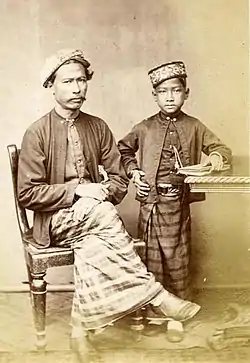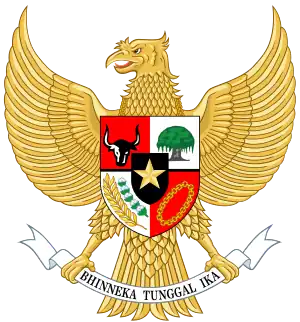ශ්රී ලංකා මැලේ ජනතාව இலங்கை மலாய் மக்கள் | |
|---|---|
 Sri Lankan Malay man and child, 19th century | |
| Total population | |
| 40,189[1] (0.2% of the population) (2012)[upper-alpha 1] Sizeable portion of Sri Lankan population with partial Malay ancestry dating back to the 13th century[upper-alpha 2] | |
| Regions with significant populations | |
| Province | |
| 24,718 | |
| 8,343 | |
| 2,889 | |
| 1,675 | |
| Languages | |
| Sri Lanka Malay language, Languages of Sri Lanka: Sinhala Some Tamil and English | |
| Religion | |
| Islam (Sunni) | |
| Related ethnic groups | |
Sri Lankan Malays (Sinhala: (ශ්රී ලංකා) මැලේ ජනතාව Shri Lanka Mæle Janathava (Standard); මැලේ මිනිස්සු / ජා මිනිස්සු Mæle Minissu / Ja Minissu (Colloquially); Tamil: இலங்கை மலாய் மக்கள், romanized: Ilaṅkai Malāi Makkal) are Sri Lankan citizens with full or partial ancestry from the Indonesian Archipelago, Malaysia, or Singapore. In addition, people from Brunei[3] and the Philippines[4] also consider themselves Malays. The term is a misnomer as it is used as a historical catch-all term for all native ethnic groups of the Malay Archipelago who reside in Sri Lanka; the term does not apply solely to the ethnic Malays. They number approximately 40,000 and make up 0.2% of the Sri Lankan population, making them the fourth largest of the five main ethnic groups in the country.
Sri Lankan Malays first settled in the country in 200 B.C., when the Austronesian expansion reached the island of Sri Lanka from Maritime Southeast Asia (which includes peoples as diverse as Sumatrans to Lucoes) and brought speakers of the Malayo-Polynesian language group to Sri Lankan shores.[5] This migration accelerated when both Sri Lanka and Indonesia were Dutch colonies (1640–1796), while a second wave (1796–1948) came from the Malay Peninsula, when both Malaya and Sri Lanka were in the British Empire. However, Sri Lanka has had a history of Malay presence dating back to as early as the 13th century.[2] Distinct to the present-day Sri Lankan Malay population, these Malay migrants were primarily Buddhists who intermarried into the Sinhalese population.[2] Sri Lankan scholars suggest that the Sinhalese population possesses a notable Malay connection due to this, meaning a significant portion of the Sri Lankan population would have at least some Malay ancestry.[2]
History
A significant Malay presence in Sri Lanka dates as far back as the 13th century, when Chandrabhanu Sridhamaraja, a Malay of Tambralinga, managed to occupy the northern part of the island in 1247; his followers assimilated into the local population.[6] Many ancestors of present-day Sri Lankan Malays were soldiers posted by the Dutch, and later by the British, for the colonial administration of Sri Lanka, who decided to settle on the island. Other immigrants were convicts or members of noble houses from the Dutch East Indies (present-day Indonesia), who were exiled to Sri Lanka and who never left. The main source of a continuing Malay identity is their common Malay language, the Islamic faith, and their ancestral origin from the Malay Archipelago. Many Sri Lankan Malays have been celebrated as courageous soldiers, politicians, sportsmen, lawyers, accountants, and doctors.
Society

| Year | Pop. | ±% |
|---|---|---|
| 1881 | 8,900 | — |
| 1891 | 10,100 | +13.5% |
| 1901 | 11,900 | +17.8% |
| 1911 | 13,000 | +9.2% |
| 1921 | 13,400 | +3.1% |
| 1931 | 16,000 | +19.4% |
| 1946 | 22,500 | +40.6% |
| 1953 | 25,400 | +12.9% |
| 1963 | 33,400 | +31.5% |
| 1971 | 43,500 | +30.2% |
| 1981 | 47,000 | +8.0% |
| 1989 (est.) | 48,000 | +2.1% |
| 2001 | 54,800 | +14.2% |
| 2011 | 40,189 | −26.7% |
| Source:Department of Census & Statistics[7] Data is based on Sri Lankan Government Census. | ||
Language
Depending on where they live in the country and other socio-economic factors, Sri Lankan Malays speak Sinhala, Tamil, and/or English. According to the 2012 census, 79.2%, or 28,975 Sri Lankan Malays also spoke Tamil and 66.2%, or 24,202 also spoke English.[8]
Religion
Like their ancestors in present-day Indonesia and Malaysia, Sri Lankan Malays are Muslim.[9] Mosques were erected by the local Malays along the coasts of Sri Lanka in places like Hambantota, Beruwela, and Galle. The Jawatte mosque in Colombo and Masjidul Jamiya, the military mosque on Slave Island, are renowned for their architecture and long history. The first two storeys of the Grand Mosque in Sri Lanka was built by Mohammed Balankaya, an exiled Malay noble of the royal house of Gowa (in present-day Sulawesi, Indonesia).[10] Today, the mosque is of great significance and is a symbol of Muslims in Sri Lanka; it is the Grand Mosque of Sri Lanka, where decisions affecting the lives of the island's Muslim population are made.[11]
Sri Lankan Malay names
First and last names among Sri Lankan Malays are mostly of Sanskrit origin and are similar (including equivalents) to names used by Sinhalese people.[12][13] Common last names include Jayah, Weerabangsa, Sinhawangsa/Sinhawansa, Jayawangsa, Singalaxana, Bangsa Jayah, and Wangsa.[12] Malay-origin last names include Lye, Samath, Cuttilan, Chunchie, Preena, Hannan, Sallay, Doole, Kitchilan, Kutinun, Kanchil, Sainon, Bongso, Bohoran, Kuppen, and Lappen.[12] Arabic names are also used by Sri Lankan Malays, including Saldin, Assan, Rahman, Drahaman, Bucker, Ramlan, Rajap, Jumat, and Mannan. Prefixes of Malay origin such as Tuan, Maas, and Raden for males and Gnei, Nona, Sitti Nona, and Gnonya for females are commonly used as first names among Sri Lankan Malays.[12][13]
Legacy
Organisations
- All Ceylon Malay Political Union
- Colombo Malay Cricket Club
- Sri Lanka Malay Association
- Malay Association Kolonnawa Electorate (MAKE)
- Conference of Sri Lanka Malays
- Dunia Melayu Dunia Islam
- Kurunegala Malay Association
Malay place names in Sri Lanka
Some place names in Sri Lanka have references indicating the presence of Javanese and Malay communities or their contribution to the location.[9] Some of these are:
- Ja Goda [14]
- Ja Kotuwa [14]
- Thavasikulam[14]
- Hambanthota (Sampan- Thota)[14]
- Taiyiddi [14]
- Thachathopu [14]
- Jawatte [14]
- Kartel [14](Slave Island)
- Ja-Ela [14]
- Javakachcheri [14](Chavakachcheri)
- street names such as Malay Street, Java Lane, Jalan Padang[14]
Notable Sri Lankan Malays
See also
Notes
- ↑ This number represents the number of Sri Lankans with Malay ancestry who settled in Sri Lanka after the 13th century, primarily during the colonial era. It is distinct from the ancient waves of migration of Malays and Javanese who settled in Sri Lanka during and prior to the 13th century, who intermarried into the Sinhalese population thousands of years ago.[2]
- ↑ This information refers to the distinct ancient waves of Malay and Javanese migrants who settled in Sri Lanka during and prior to the 13th century and intermarried into the Sinhalese population thousands of years ago.[2]
References
- ↑ "A2 : Population by ethnic group according to districts, 2012". Census of Population & Housing, 2011. Department of Census & Statistics, Sri Lanka.
- 1 2 3 4 5 Goonewardene, K.W. (July 1843). "Journal of the Royal Asiatic Society Vol. VII". Journal of the Royal Asiatic Society. 7: 257. Retrieved 21 April 2020.
- ↑ "The Malay Identity in Brunei Darussalam and Sri Lanka" By B. A. Hussainmiya(Universiti Brunei Darussalam)
- ↑ "Locating the Filipino as Malay: A Reassertion of Historical Identity from the Regional Periphery" Published online by Cambridge University Press (20 January 2020)
- ↑ "Astronesians Historical and Comparative Perspectives" Page 146 "Annual trade between China and India through the Malacca Straits had opened by about 200 BC. Perhaps by that time Austronesian sailors were regularly carrying cloves and cinnamon to India and Sri Lanka, and perhaps even as far as the coast of Africa in boats with outriggers. Certainly they have left numerous traces in canoe design, rigs, outriggers and fishing techniques, and a mention in Greek literature (Christie 1957)."
- ↑ "Malays in Sri Lanka".
- ↑ "Population by ethnic group, census years" (PDF). Department of Census & Statistics, Sri Lanka. Archived from the original (PDF) on 13 November 2011. Retrieved 23 October 2012.
- ↑ "Census of Population and Housing 2011". www.statistics.gov.lk. Department of Census and Statistics. Retrieved 14 November 2018.
- 1 2 Kalabooshana S. B. C. Halaldheen (25 January 2002). "Features: Sri Lanka Malays in focus". Daily News. Archived from the original on 27 April 2003.
- ↑ B. D. K. Saldin (1996). Orang Melayu Sri Lanka Dan Bahasanya. Sridevi Printers Publication. p. 17. ISBN 95-594-1902-1.
- ↑ DK Eyewitness Travel Guide Sri Lanka. Dorling Kindersley Ltd. 2016. p. 69. ISBN 978-02-412-8997-6.
- 1 2 3 4 Hussainmiya, Bachamiya Abdul (1987). Lost Cousins: The Malays of Sri Lanka. Institut Bahasa. p. 8.
- 1 2 "Names in Sri Lanka". asian-recipe.com. Asian-Recipe. 2 January 2020. Retrieved 20 April 2020.
- 1 2 3 4 5 6 7 8 9 10 11 Mohammed Zameer Careem (Tuan) (2016). Persaudaraan (brotherhood): Malay Life in Sri Lanka. S. Godage & Brothers. ISBN 9789553069047.
